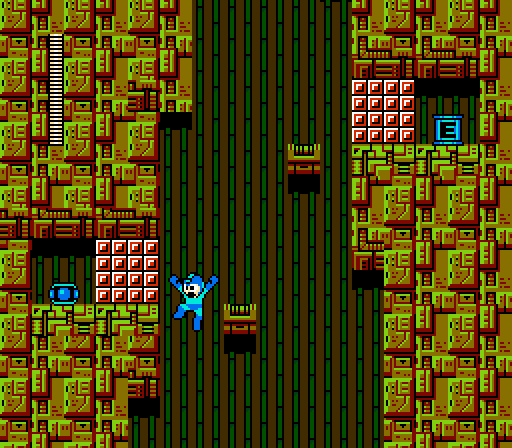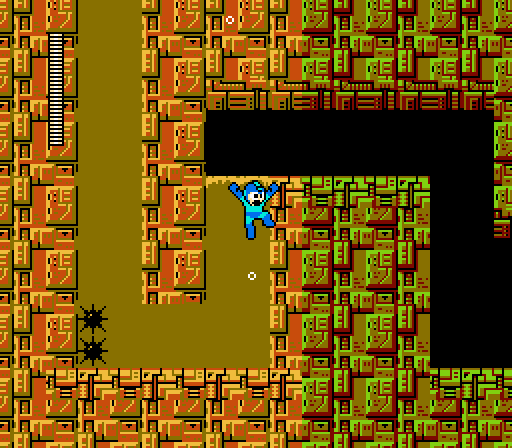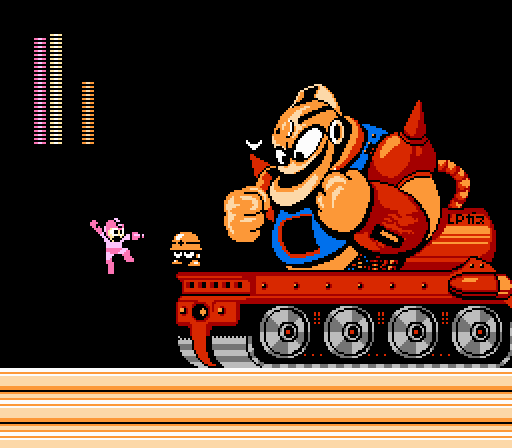The background music changes for the third leg of Dr. Wily’s castle, from the majestic theme of the previous two stages to a more muted loop that constantly builds to a crescendo, rising in pitch and intensity, but never quite breaks. Instead, it drops right as it seems like it’s reaching a climax and begins the loop anew. It help builds the tension and anxiety of this stage… which, honestly, doesn’t need much help.
Wily’s third stage represents a turning point in level design. There’s no more hand-holding, no easy way through. At this point, the game has officially become mean and nasty.
Case in point: You begin the level by immediately dropping into a shaft with some power-ups… but if you want them, you have to burn through a bunch of precious Crash Bombers. You can refill on the next screen (if you land in the right spot and don’t plunge down to the bottom instead), but this represents a hefty outlay of energy for a weapon that, if you’ve played the game before, you know you should conserve with all desperation. If you don’t know what lay ahead, well, you could very easily screw yourself over right here.
This area is light on enemies, and this initial drop features only a single one: One of those snails from Bubble Man’s stage. That should give you a clue for what’s next…
Water! But not refreshing clean natural water as you saw at Bubble Man’s waterfall. No, this is a gunky green reservoir that reeks of stagnation (quite possibly literally, assuming Dr. Light built olfactory sensors into Mega Man). Sewage? Runoff? Some kind of lubricant reservoir for all of Wily’s machines? In any case, the hideous color scheme makes you feel almost as unwelcome in this area as the mine lining nearly every visible surface of the underwater area. And to say nothing of that giant fish.
Said fish appears in duplicate here, a nasty surprise to waylay you as you leap across the two deadly pits in this area. The designers were nice enough to add a transition from flat greenish background to murky black at the bottom of the pits to denote quite clearly that you shouldn’t try dropping into these pits — a sensibly consideration, given the way water changes the physics and rules of Mega Man’s control scheme — but there’s no hint at the horror lurking below the dark until you take a running jump to clear the watery expanses. Once you step off the surrounding ledge, this massive thing darts upward and tries to take a massive bite of Mega Man. Should it hit Mega Man, it can easily stall his momentum and send him dropping into the pit from which the fish leapt.
The Big Fish may be the strangest enemies in the game. There are only two of them, and they don’t quite fit the overall design aesthetic of Mega Man 2. They present an oddly flat appearance, lacking the highlights and shading that even tiny Wily robots possess — and they definitely lack the cartoonish grandeur of the game’s bigger robot foes. In a way, though, that works to their benefit. It helps convey the alien sensation of this leg of the stage; you weren’t meant to be here, in this foul sewer where only Wily’s incomplete and imperfect creations dwell.
Ostensibly, the Big Fish are invincible — everything simply bounces off their skin. Right? Well, almost; everything bounces off their skin except Quick Boomerangs and Crash Bombers. Hilariously, the weakest weapon in the game will utterly destroy a Big Fish in a single shot, causing it to vanish with a tiny little explosion like you’d expect from one of the minor robots you face in other stages. Apparently this vulnerability was removed for the Mega Man 2 portion of The Wily Wars, which only goes to convey the idea that this is a sort of oubliette for Wily’s rejects and that you’re infiltrating the castle through an unintended route. One imagines Wily watching this sequence on his security monitors and fuming because Mega Man totally bypassed all the cool, colorful, fun defenses designed for the main route. Sorry, Wily. Like Robert Plant, Mega Man likes to be a back-door man.
Once you make your way past the Big Fish, the remainder of the stage consists almost entirely of passive threats: Namely, narrow passages lined by a seemingly endless array of mines. This here is the original 1001 Spikes, my friends.
Once you drop into the depths beyond the Big Fish, you’re forced to navigate the trickiest jump in the entire game: A plunge into a shaft four screens high with no platforms, no stops, just a continuous fall through a twisting tube whose every surface will destroy Mega Man on contact. You have one chance to get it right…
And yet, this jump is neither unreasonable nor unfair. The mouth of the passage at the top is rimmed by mines, so you know exactly what you’re getting into and will instinctively aim for the center of the shaft as you leap, to keep you as far away from the instant-kill hazards as possible. Once you drop to the next screen, the tunnel bends to the left in such a way that you’ll hit the mines if you drop into the center of the shaft; you have just a split-second to steer Mega Man to the safety at the left side. You need great reflexes here, not to mention a light touch to prevent oversteering.
The saving grace, however, is in one of the game’s fundamental mechanics — when you make a vertical transition between two screens, the game freezes momentarily and slides slowly from one screen to the next, similar to the screen transitions in The Legend of Zelda. In this case, that two seconds of inactivity gives you a preview of sorts of the hazards that lay below as you slide to the next screen. You’re meant to use the brief pause as an opportunity to scout the passage and plan your next move, then execute that plan the instant you resume control. The designers use what appears to be a technical limitation of the Mega Man 2 game engine to create a tricky, nerve-wracking challenge — a brilliant bit of game design.
Eventually, you’ll land on a platform, at which point the remainder of the mine gauntlet is a breeze. There’s an amusing final touch, though: These two mines at the very bottom left of the shaft. Just in case you got cocky or sloppy when you ran left to drop into the final descent from the platform above and pushed all the way left. But, if you can avoid those, you’re done with the water and can leap to dry land at the top of the lower airlock. A trio of Shotmen await you here, though after completing such a tense drop you can cheerfully laugh at them for representing such a trivial threat.
Finally, the boss, a rather familiar-looking fellow on quite a grand scale. Yes, it’s Guts Man from the original Mega Man, but somewhat larger than you’re likely to remember him. Apparently Dr. Wily abandoned the scheme to mass manufacture Guts Man (hinted at in the background graphics of the final Wily stage in Mega Man) and decided instead to go for scale rather than numbers. Guts Man has been redesigned into a massive battle tank.
Though maybe not a very good one. That cylinder on the back side of the tank reads “LP gas,” so basically it’s full of highly volatile liquid propane. Since this is a 2D platformer, of course, Mega Man can’t simply run around behind Guts Dozer to fire a Crash Bomber at the gas tank. Look at those spikes on the shoulders! Instant death, right there. No, instead you have to take on Guts Dozer from the front.
Naturally, the construct is only vulnerable in its face, and it’s invulnerable to your weapons that have the ability to fire upward (Metal Blade and Air Shooter). In fact, just to be nasty, one of the few weapons that works against Guts Dozer is the Bubble Lead, which is easily the single most disadvantageous weapon you could possibly use here. In any case, you have to climb up to attack, even as Guts Dozer disgorges an endless stream of hopping Metools from its chest — they move forward rapidly in small, bounding arcs.
While the Metools present the main challenge here, they also hint at the solution to this battle. When Guts Dozer releases one, it hops along the top edge of the tank’s lower platform: Your clue that it is, in fact, a platform in the design sense of the word as well. You can safely stand on the front edge of the tank to use as your staging ground for jumping and shooting Guts Dozer’s massive face. This does make you somewhat vulnerable to the Metools, but the tank has a tell for that attack. It raises its left (well, its right, your left) fist to create a path for the Metools. This is its only attack — it doesn’t attempt to punch or crush you, just rolls back and forth while spitting out little hardhat dudes — so once you figure out the secret and the timing, it’s a pretty easy fight. In fact, it goes really fast once you realize its weakness is Quick Boomerang and that, unlike Robot Masters, Guts Dozer doesn’t enjoy any post-damage invincibility. You can pump him full of projectiles and win this fight in a remarkably short amount of time.
So ultimately, Guts Dozer is pretty underwhelming. But he sure looks cool.





Wow, I never noticed the katakana on Gutsdozer before. That’s in the US release too? (Of course, the first time I played it, I wouldn’t have had any idea what it was.)
It would be interesting if ol’ Big Guts tried to punch you in the face occasionally too (presumably with a different tell), but I expect these bosses were already running up against limits in the amount of sprites and animation programmers had manages to coax from the NES at the time it was made.
Yeah, seems like a missed opportunity, but you can start to see the strain the tech limitations inflicted around this part of the game.
I believe both Guts and Mecha Dragon are employing the same background-as-boss trickery (which is why they are both fought against otherwise featureless backgrounds). I don’t believe this technique got reused in the later games even though it seems like a good workaround to the number and size limitations of NES sprites.
It did get used in the later games. The Yellow Devil and Gamma in MM3, almost all of the bosses in the two castles in MM4 (except for the Cockroach Twins), all of the bosses in Wily’s Castle in MM5, most of X and Wily’s bosses in MM6, all of the Wily Machines in 1-6, and (I mention out of order) the Yellow Devil in MM1 are all background enemies, sometimes with a single non-background element to actually target. Even the Wily Capsules seem to be done this way.
In fact, pretty much any giant boss in any game on the NES was done this way (with the exception of the boxers in Mike Tyson’s Punch-Out, which instead used a special chip in the cartridge)
Really O_O Yellow Devil makes total sense, of course, but you could see the hardware _strain_ with the effort of displaying Mecha Dragon and Guts Dozer and the later games just didn’t have the same issue. Programmers must have really taken what they learned from MM2 for future installments.
The difference was more to do with technology, actually. Mega Man 2 used the MMC1 chip, while the subsequent NES Mega Man games used the more advanced MMC3.
I always thought the Shotmen at the end were actually really poorly placed. They shoot immediately after appearing, meaning you’ll almost certainly get hit unless you know exactly where they are. It’s especially unfriendly to new players, although the lack of other non-fatal threats means that it’ll rarely cause an end to your run.
Also, between the Big Fish, and the identical (palette-swapped) tileset throughout Wily stages 2, 3, and 4, I think this is the point where Mega Man 2 skimped on its visuals a bit. It’s not too surprising, since Mega Man 2 was sort of an off-the-books project and so probably didn’t have the same budget, but if you compare this part to the rest of the game, or other Mega Man titles, it definitely falls short.
For what little it’s worth, in Wily Wars (the Genesis remake of MMs 1-3, which isn’t very good due to being astoundingly laggy) both the fish and guts-tank have been recolored to take on a more metallic sheen. And since the Genesis has a free background layer, the black backgrounds against the tank here and the dragon in Wily 1 are given more detail — but I think that actually detracts a bit from the originals since the detail draws attention away from the large bosses and makes the arenas feel less severe/brutalist.
Hm, do the shoulder spikes really kill you instantly? I can’t say I’ve ever tried getting past them.
Also, not sure I ever really noticed the way the background texture changes in the middle of the screen in that last shot before Guts Dozer.
Oh, and the LP seems to be “liquid petroleum,” rather than propane. 😉
Hank Hill does NOT approve.